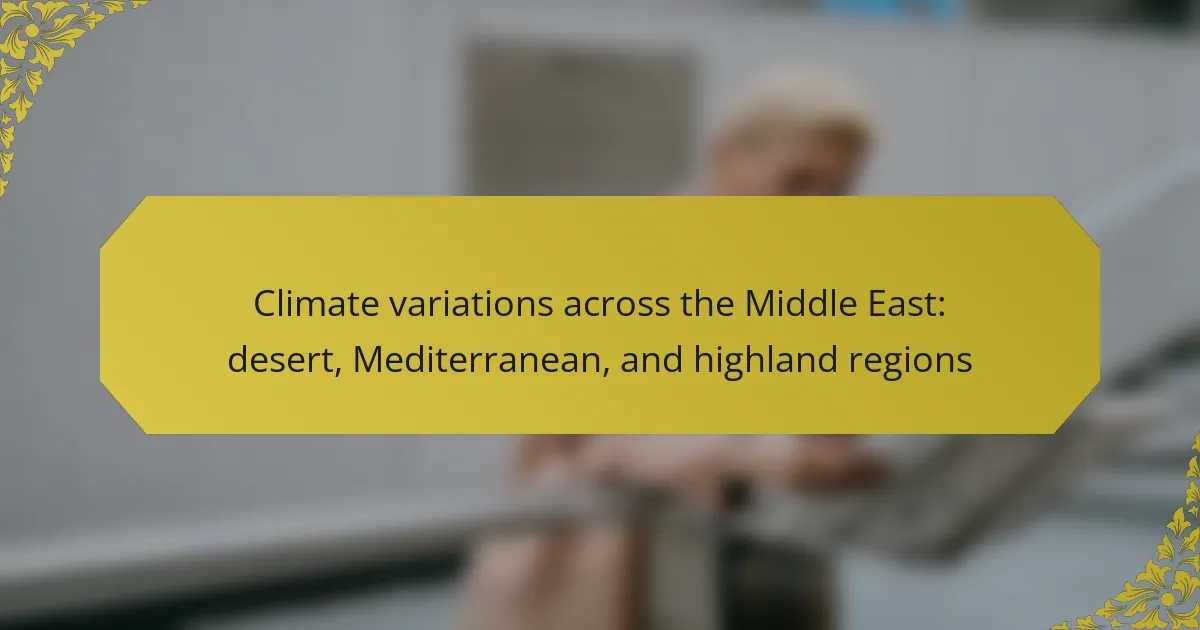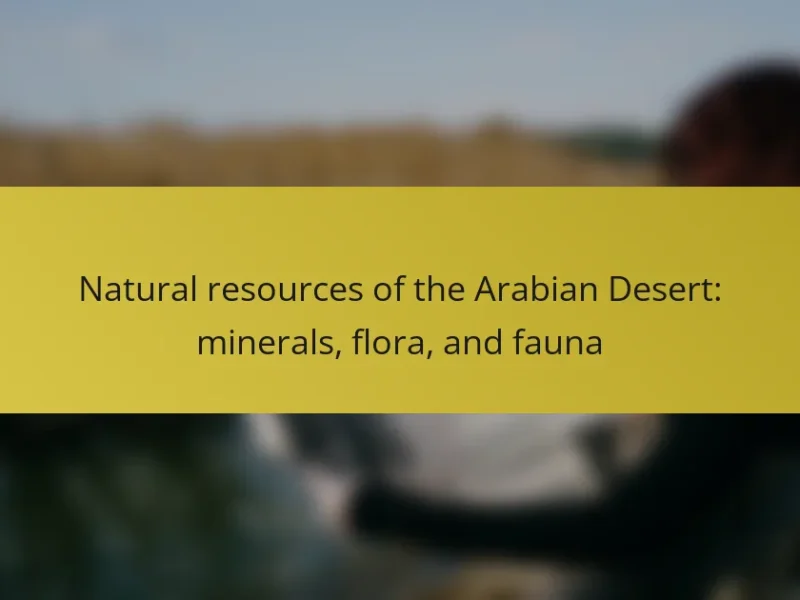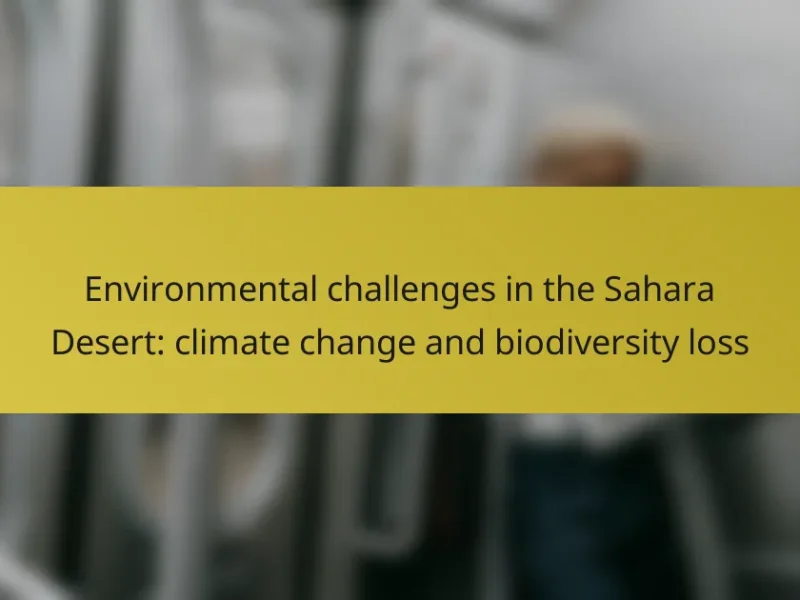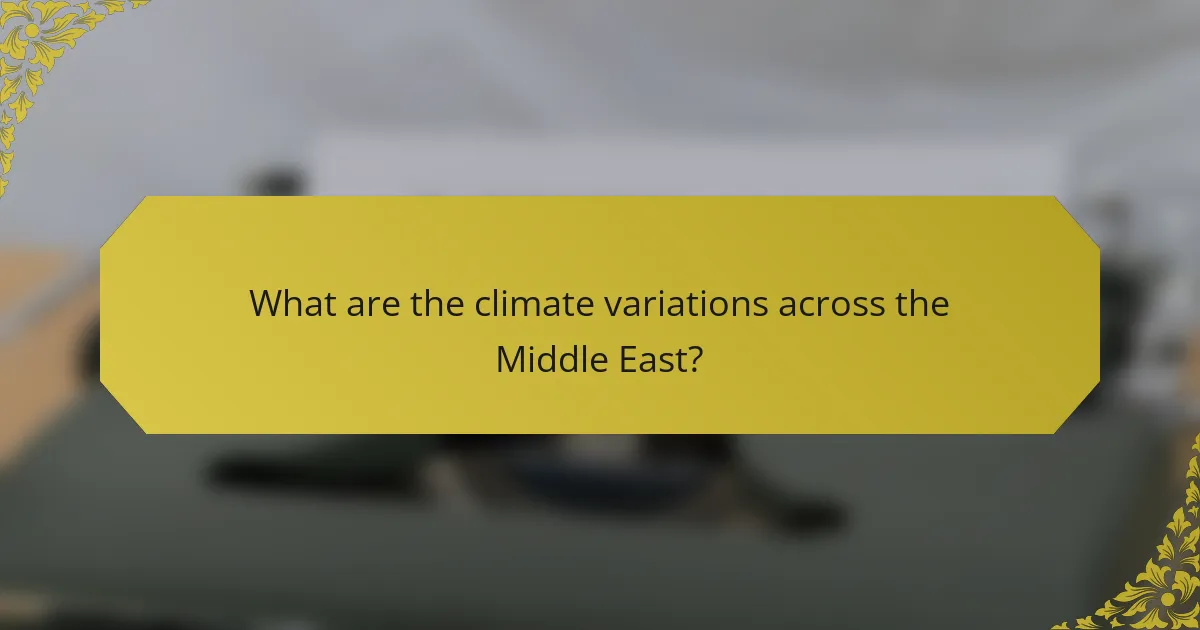
What are the climate variations across the Middle East?
The climate variations across the Middle East include desert, Mediterranean, and highland climates. Desert climates dominate the region, characterized by low precipitation and high temperatures. Countries like Saudi Arabia and Iraq experience arid conditions with less than 250 mm of annual rainfall. Mediterranean climates are found along coastal areas, such as in Lebanon and parts of Turkey. These regions have wet, mild winters and hot, dry summers. Highland climates occur in elevated areas, like the Iranian Plateau, with cooler temperatures and more precipitation. The combination of these climate types creates diverse ecosystems and agricultural practices throughout the Middle East.
How do the desert regions influence the overall climate?
Desert regions significantly influence the overall climate by creating arid conditions. They absorb and retain heat during the day, leading to high temperatures. At night, deserts cool rapidly, causing temperature swings. This heat absorption affects nearby areas, contributing to regional climate patterns. Deserts also limit moisture availability, impacting precipitation levels. The presence of deserts can lead to the formation of high-pressure systems. These systems often suppress cloud formation and rainfall. Consequently, areas adjacent to deserts experience dry climates. Climate data shows that deserts can extend arid zones over vast distances.
What are the key characteristics of desert climates in the Middle East?
Desert climates in the Middle East are characterized by low precipitation, high temperatures, and arid conditions. Annual rainfall typically measures less than 250 millimeters. Daytime temperatures can exceed 40 degrees Celsius in summer months. Nights can be significantly cooler, sometimes dropping to near freezing. The region experiences high evaporation rates due to intense sunlight. Vegetation is sparse, mainly consisting of drought-resistant plants. Soil quality is often poor, with sandy or rocky terrain. These features create a unique ecosystem adapted to extreme conditions.
How do temperature and precipitation patterns differ in these areas?
Temperature and precipitation patterns significantly differ across the desert, Mediterranean, and highland regions of the Middle East. Desert regions experience extreme temperatures, often exceeding 40°C in summer and dropping to near freezing in winter. Precipitation in deserts is minimal, averaging less than 250 mm annually. In contrast, Mediterranean regions have milder temperatures, with summer averages around 30°C and winter averages between 5°C and 15°C. These areas receive more rainfall, typically between 400 mm and 800 mm annually, concentrated in winter months. Highland regions exhibit cooler temperatures, often below 20°C in summer and can drop significantly in winter. Precipitation in highlands is variable but can exceed 1,000 mm annually, often falling as snow in winter. These patterns reflect the geographical and climatic diversity present across the Middle East.
What defines the Mediterranean climate in the Middle East?
The Mediterranean climate in the Middle East is characterized by hot, dry summers and mild, wet winters. This climate type typically features average summer temperatures exceeding 30°C. Winters are generally cooler, with temperatures averaging around 10-15°C. Precipitation is concentrated in the winter months, averaging 400-800 mm annually. This climate supports diverse ecosystems, including forests and shrubs. Regions such as coastal Lebanon and parts of Israel exemplify this climate. The Mediterranean climate is influenced by geographical features, such as proximity to the sea and elevation. These factors contribute to its distinct seasonal patterns and biodiversity.
What are the seasonal variations in Mediterranean regions?
Mediterranean regions experience distinct seasonal variations characterized by hot, dry summers and mild, wet winters. Summer temperatures often exceed 30°C (86°F), with minimal rainfall. In contrast, winter temperatures typically range from 5°C to 15°C (41°F to 59°F). Precipitation is concentrated in the winter months, averaging 400 to 800 mm annually. These regions also exhibit a marked transition in vegetation, with drought-resistant plants thriving in summer and lush greenery appearing in winter. The climatic patterns are influenced by the Mediterranean Sea, which moderates temperatures and affects humidity levels.
How do geographical features affect the Mediterranean climate?
Geographical features significantly influence the Mediterranean climate. Mountain ranges, such as the Alps and the Atlas Mountains, block cold winds from the north. This results in warmer temperatures in coastal areas. Proximity to large bodies of water moderates temperature extremes. The Mediterranean Sea provides moisture, leading to wetter winters. Valleys and plains can experience different microclimates due to elevation changes. Coastal regions typically have milder climates than inland areas. These geographical features create distinct seasonal patterns, including dry summers and wet winters. The interplay of these factors shapes the unique characteristics of the Mediterranean climate.
What are the unique attributes of highland climates in the Middle East?
Highland climates in the Middle East are characterized by cooler temperatures and higher precipitation compared to surrounding areas. These climates typically occur at elevations above 1,500 meters. The temperature range can vary significantly, with colder winters and mild summers. Highland regions often experience orographic rainfall due to moist air rising over mountains. Vegetation in these areas includes forests and grasslands, unlike the arid deserts nearby. Soil quality is generally better, supporting agriculture. The unique biodiversity includes species adapted to cooler conditions. Examples of highland climates in the Middle East can be found in the Zagros Mountains and the Taurus Mountains.
How do altitude and topography influence climate in highland areas?
Altitude and topography significantly influence climate in highland areas. Higher altitudes generally lead to cooler temperatures. For instance, temperatures can drop by approximately 6.5 degrees Celsius for every 1,000 meters of elevation gain. Topography affects precipitation patterns as well. Mountains often create rain shadows, where one side receives ample rainfall and the other remains dry. This phenomenon can lead to distinct climatic zones within short distances. Additionally, highland areas may experience increased cloud cover and humidity. These factors contribute to unique ecosystems and biodiversity in these regions. Overall, altitude and topography play crucial roles in shaping the climate of highland areas.
What are the temperature and moisture patterns in these regions?
Desert regions in the Middle East experience high temperatures and low moisture. Average summer temperatures can exceed 40°C. Annual precipitation is often below 250 mm, leading to arid conditions. The Mediterranean regions have milder temperatures and higher moisture levels. Summer temperatures range from 25°C to 35°C. These areas receive between 400 mm and 800 mm of rainfall annually, primarily in winter. Highland regions show significant temperature variation. They can have cool summers and cold winters. Precipitation in highlands can exceed 1,000 mm annually, supporting diverse ecosystems.
How do these climate variations impact local ecosystems?
Climate variations significantly impact local ecosystems by altering species composition and habitat conditions. In desert regions, increased temperatures and reduced rainfall lead to water scarcity, affecting plant and animal survival. For instance, many desert plants have adapted to conserve water, while animal species may migrate or enter dormancy during extreme heat. In Mediterranean areas, seasonal droughts can stress vegetation, resulting in shifts toward drought-resistant species. These ecosystems often experience increased fire frequency, which can further change species dynamics. In highland regions, temperature variations can affect snowmelt timing, impacting water availability for downstream ecosystems. A study by the Intergovernmental Panel on Climate Change highlights that ecosystems are highly sensitive to climate changes, with many species facing increased extinction risks due to habitat loss and altered environmental conditions.
What are the implications of climate variations for agriculture in the Middle East?
Climate variations significantly impact agriculture in the Middle East. Increased temperatures lead to reduced crop yields. Drought conditions are becoming more frequent, affecting water availability. Soil degradation is exacerbated by changing rainfall patterns. Crop varieties may struggle to adapt to new climate conditions. Farmers face challenges in pest and disease management due to climate shifts. Economic stability in agriculture is threatened by these variations. The region’s reliance on agriculture makes it vulnerable to climate change effects.
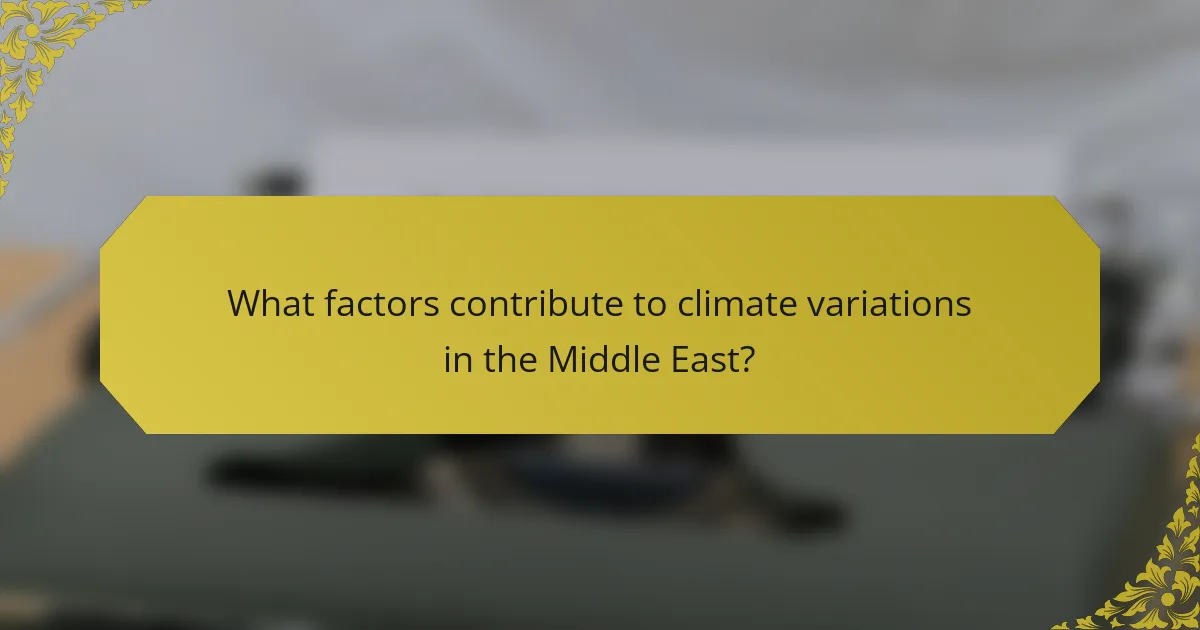
What factors contribute to climate variations in the Middle East?
Climate variations in the Middle East are influenced by several key factors. Geographic location plays a significant role, as the region includes deserts, mountains, and coastal areas. The presence of the Arabian Desert contributes to extreme temperatures and low precipitation levels. Proximity to bodies of water, such as the Mediterranean Sea, creates milder climates in coastal regions. Elevation differences also affect climate; higher altitudes in mountainous areas result in cooler temperatures and increased rainfall. Additionally, prevailing wind patterns, such as the Shamal winds, can lead to variations in temperature and humidity. Human activities, including urbanization and land use changes, further impact local climates. These factors collectively shape the diverse climatic conditions observed across the Middle East.
How do ocean currents and winds influence regional climates?
Ocean currents and winds significantly influence regional climates by distributing heat and moisture across the globe. Ocean currents, such as the Gulf Stream, transport warm water from the equator to higher latitudes. This process moderates temperatures in coastal regions, leading to milder climates. Winds, particularly trade winds and westerlies, also play a crucial role in climate patterns. They help transport moisture-laden air, affecting precipitation levels in various regions. For example, in the Middle East, the Mediterranean Sea influences local climates by providing moisture, which affects rainfall patterns. In contrast, desert regions experience dry conditions due to the influence of surrounding high-pressure systems. Thus, the interaction between ocean currents and winds shapes the diverse climates found across the Middle East.
What role do the surrounding bodies of water play in climate regulation?
Surrounding bodies of water play a crucial role in climate regulation by moderating temperatures. They absorb heat during the day and release it at night, reducing temperature extremes. This process is known as thermal inertia. In the Middle East, seas and large lakes influence local climates, creating milder conditions. For example, the Mediterranean Sea affects coastal regions, leading to wetter winters and drier summers. Additionally, bodies of water contribute to humidity levels, affecting precipitation patterns. The interaction between land and water also impacts wind patterns, further influencing climate. Overall, surrounding water bodies are essential for maintaining climate stability in the region.
How do prevailing winds affect weather patterns across the region?
Prevailing winds significantly influence weather patterns across the Middle East. These winds determine temperature, precipitation, and humidity levels. For instance, the Shamal wind brings dry air from the north, leading to arid conditions in desert areas. Conversely, the Mediterranean winds carry moist air, resulting in wetter climates along coastal regions. In highland areas, prevailing winds can cause orographic rainfall, enhancing local moisture. Seasonal variations in wind direction also contribute to temperature fluctuations. Studies show that these wind patterns are integral to understanding regional climate dynamics.
What human activities impact climate in the Middle East?
Human activities significantly impact climate in the Middle East. Deforestation for agriculture and urban development reduces vegetation cover. This loss of trees leads to increased carbon emissions. Industrialization contributes to air pollution, affecting local weather patterns. Water extraction from rivers and aquifers alters hydrological cycles. Overgrazing by livestock depletes soil quality and increases desertification. Fossil fuel extraction and burning release greenhouse gases. These activities combined exacerbate climate change effects in the region.
How does urbanization affect local climate conditions?
Urbanization significantly alters local climate conditions. It leads to the urban heat island effect, where cities become warmer than surrounding rural areas. This occurs due to the concentration of buildings, roads, and other infrastructure that absorb and retain heat. Additionally, urbanization often reduces vegetation cover, which diminishes natural cooling processes. The loss of green spaces contributes to increased temperatures and altered precipitation patterns. According to the U.S. Environmental Protection Agency, urban areas can be up to 5°F warmer than their rural counterparts. Furthermore, urbanization can affect local wind patterns and humidity levels, further changing climate dynamics.
What is the effect of agriculture and land use changes on climate?
Agriculture and land use changes significantly affect climate. These activities alter the natural landscape and can lead to increased greenhouse gas emissions. Deforestation for agricultural expansion releases carbon stored in trees. Additionally, soil disturbance during farming can release carbon dioxide and methane. Changes in land use also impact local weather patterns. For instance, converting forests to agriculture can reduce rainfall in the area. According to the Intergovernmental Panel on Climate Change, land use changes contribute to approximately 23% of global greenhouse gas emissions. These emissions are a major driver of climate change. Thus, agriculture and land use changes play a critical role in shaping the climate.
How do climate variations affect water resources in the Middle East?
Climate variations significantly impact water resources in the Middle East. Changes in temperature and precipitation patterns lead to altered river flows and groundwater levels. For example, increased evaporation rates due to higher temperatures can reduce surface water availability. Additionally, prolonged droughts can diminish water supplies, affecting agriculture and drinking water. The Intergovernmental Panel on Climate Change (IPCC) reports that many regions in the Middle East may experience a decrease in annual rainfall by up to 20% by 2050. This reduction threatens the sustainability of water resources in the region, exacerbating existing water scarcity issues.
What strategies can be implemented to mitigate climate-related challenges?
Implementing strategies to mitigate climate-related challenges involves several key actions. First, enhancing water management systems is crucial. Efficient irrigation techniques can reduce water waste in agriculture. Second, promoting renewable energy sources decreases reliance on fossil fuels. Solar and wind energy are particularly viable in the Middle East. Third, reforestation and afforestation can improve carbon sequestration. Planting trees in urban and rural areas helps absorb CO2. Fourth, adopting sustainable agricultural practices increases resilience against climate impacts. Crop rotation and organic farming enhance soil health. Fifth, improving urban planning can reduce heat islands. Green spaces in cities lower temperatures and improve air quality. These strategies are supported by various studies. For instance, a report by the World Bank emphasizes the importance of water conservation in arid regions.

What are the future trends in climate variations across the Middle East?
Future trends in climate variations across the Middle East indicate increased temperatures and altered precipitation patterns. Projections show that average temperatures may rise by 1.5 to 3 degrees Celsius by 2050. This warming will exacerbate existing arid conditions, particularly in desert regions. Rainfall is expected to become more erratic, with some areas experiencing severe droughts. For instance, the Mediterranean region may see a reduction in winter rainfall by up to 30%. Additionally, extreme weather events, such as heatwaves and flash floods, are likely to increase in frequency. These changes will impact water resources, agriculture, and biodiversity across the region. Studies highlight that addressing these trends is crucial for sustainable development and regional stability.
How is climate change expected to alter the existing climate patterns?
Climate change is expected to significantly alter existing climate patterns. It will increase temperatures across the Middle East, leading to more frequent heatwaves. Precipitation patterns will also change, resulting in reduced rainfall in some areas and increased intensity in others. These shifts can cause prolonged droughts in desert regions. Mediterranean climates may experience wetter winters and drier summers. Highland areas could face alterations in snowfall and snowmelt timing. A study by the Intergovernmental Panel on Climate Change (IPCC) indicates that these changes threaten water resources and agriculture. The projected temperature rise by 1.5°C could exacerbate these effects, impacting biodiversity and human livelihoods.
What projections exist for temperature and rainfall changes?
Projections for temperature changes in the Middle East indicate an increase of 1.5 to 4 degrees Celsius by the end of the century. This rise is attributed to climate change trends observed globally. Rainfall projections show a decrease of 10 to 30 percent in many areas. The Mediterranean region may experience more intense rainfall events, but overall annual precipitation is expected to decline. These projections are supported by the Intergovernmental Panel on Climate Change (IPCC) reports. The reports detail regional climate models that predict these shifts based on current emission scenarios.
How might these changes impact biodiversity in the region?
Changes in climate variations across the Middle East can significantly impact biodiversity in the region. Increased temperatures and altered precipitation patterns may lead to habitat loss for various species. Desertification can threaten plant and animal life, reducing their populations. Mediterranean ecosystems may experience shifts in species composition due to changing climatic conditions. Highland areas could see the migration of species to higher altitudes, disrupting existing ecosystems. These alterations can result in decreased genetic diversity among species, making them more vulnerable to extinction. Studies indicate that climate change could lead to a decline in species richness and abundance in these diverse habitats.
What adaptation strategies can communities adopt in response to climate variations?
Communities can adopt several adaptation strategies in response to climate variations. These strategies include implementing water conservation techniques. Efficient irrigation systems can reduce water waste in agriculture. Rainwater harvesting can provide additional water sources during dry periods. Communities can also develop heat-resistant crop varieties. This adaptation ensures food security under changing climatic conditions. Infrastructure improvements can protect against flooding and extreme weather events. Urban planning can incorporate green spaces to mitigate heat effects. Education and awareness programs can empower communities to respond effectively. These strategies have been shown to enhance resilience against climate impacts in various regions.
How can sustainable practices help mitigate climate impacts?
Sustainable practices can help mitigate climate impacts by reducing greenhouse gas emissions and conserving resources. Implementing renewable energy sources, such as solar and wind, decreases reliance on fossil fuels. Energy efficiency measures lower overall energy consumption. Sustainable agriculture practices enhance soil health and reduce emissions from farming activities. Water conservation techniques address scarcity and improve resilience to climate variations. Urban planning that incorporates green spaces helps reduce urban heat and improve air quality. According to the Intergovernmental Panel on Climate Change, transitioning to sustainable practices can significantly lower global warming potential.
What role does policy play in addressing climate challenges in the Middle East?
Policy plays a crucial role in addressing climate challenges in the Middle East. It shapes regulations and frameworks for environmental protection. Effective policies can promote renewable energy adoption and reduce greenhouse gas emissions. For instance, the UAE’s Energy Strategy 2050 aims to increase clean energy’s contribution to the energy mix to 50%. Policy also facilitates regional cooperation on water management and climate adaptation strategies. The Arab Climate Change Action Plan emphasizes collaboration among Arab states to tackle climate issues. Furthermore, policies can incentivize sustainable agricultural practices to combat desertification. Countries like Jordan implement policies to enhance water conservation amidst scarcity. Thus, policy is integral to creating a sustainable response to climate challenges in the region.
What practical measures can individuals take to adapt to climate variations?
Individuals can adapt to climate variations by implementing water conservation techniques. These techniques include rainwater harvesting, which can collect and store water for later use. Installing efficient irrigation systems, such as drip irrigation, reduces water waste in agriculture.
Additionally, individuals should consider planting drought-resistant crops. These crops are better suited to withstand dry conditions. Utilizing shade structures can protect plants and reduce evaporation.
Another practical measure is to improve energy efficiency in homes. This can be achieved by using energy-efficient appliances and proper insulation.
Lastly, participating in local environmental programs can promote community resilience. Engaging in tree planting or habitat restoration helps mitigate climate impacts.
These measures collectively enhance adaptability to the diverse climate variations found in the Middle East.
The main entity of the article is the climate variations across the Middle East, specifically focusing on desert, Mediterranean, and highland regions. The article provides an in-depth analysis of the distinct climate types, their characteristics, and how they influence local ecosystems, agriculture, and water resources. It explores the factors contributing to these variations, including geographic features, prevailing winds, and human activities. Additionally, it discusses future trends in climate change and outlines adaptation strategies for communities and individuals to mitigate the impacts of these climatic changes.
